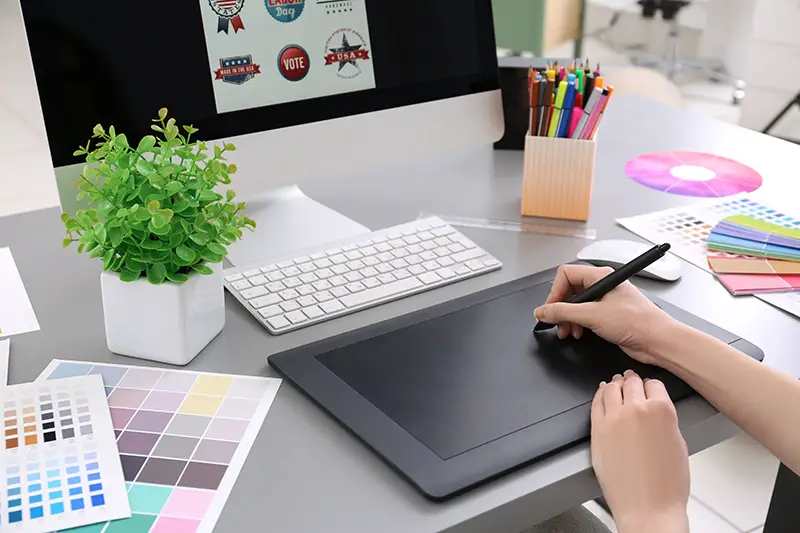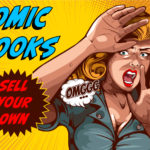Moving from hand-drawing on paper to using a drawing or graphics tablet can take a lot of getting used to. Whilst there are a number or adjustments you’ll need to make, one significant one is to the feel of the drawing surface.
Drawing on plastic or glass, for the most part, does not feel like the paper. You will either get used to this new surface with time or you can attempt to make your drawing tablet feel like paper, potentially as a temporary measure. That being said, not everyone actually wants a feeling of paper from their tablet but if you do then this post will highlight the options open to you.
To recreate the feel of paper you can replace the drawing surface with a textured one or buy a tablet that already has this. Alternatively, use a pen nib that provides an increased level of resistance. There are also tablets that allow you to draw onto paper and capture your strokes at the same time. A workaround is to place paper on top of your drawing tablet and draw onto that.
If you find this post useful then you might enjoy Scratches on a Drawing Tablet: Do They Matter? and How to Stop a Drawing Tablet Sliding When Drawing.
Let’s go through the suggestions in more detail…
Buy a Tablet that Captures Real Pen-Strokes
Wacom Intuos Pro Paper Edition
Wacom produce the Intuos Pro Paper Edition which is a clever piece of kit. The tablet allows you to clip a piece of paper onto the drawing surface and the stylus pen includes real ink. You are then able to draw using an actual pen and have your strokes captured digitally at the same time.
You can switch to the normal stylus pen and use the tablet as if it were a standard Intuos Pro as well. The price-tag is pretty hefty but in my mind this option is the best of both worlds if you can afford it. It is still a cheaper option than some pen displays however. Check out Wacom’s product trailer below:
The additional benefit of this tablet is that you can still look at the same surface that you’re drawing onto rather than a monitor. This achieves some of what Pen Displays are designed to solve but with a less costly solution.
Check out the latest price of the Wacom Intuos Pro Paper Edition on Amazon here (paid link).
ISKN Repaper
The ISKN Repaper is another tablet that tries to achieve what the Wacom does but uses a magnetic ring placed around your own pencil or pen instead of a dedicated stylus pen. The Repaper is a lot cheaper than the Wacom and hence it is unfair to compare the performance directly. See the product on Amazon here (paid link).
Buy a Paper-Feel Drawing Tablet
Manufacturers of drawing tablets understand that some of their customers just prefer a level of resistance akin to drawing on paper. The drawing surface textures will vary across brands and also within product ranges with some offering better textures as more premium features. When buying a new tablet it is important to try them out before buying if you can so that you can get the right texture for you.
Which Drawing Tablets Feel Like Paper?
Wacom
Wacom well known to have superior surface textures for their tablets. They are particularly good at replicating the feel of paper on their Intuos tablets with the Pro emulating it the best. With their Cinitiq display tablets you will need to opt for the more expensive Pro versions that feature etched glass screens to get the best feel.
XP-Pen
XP-Pen make some decent tablets but are typically are not quite as good at replicating the paper-feel that Wacom products do. Their surfaces tend to be smoother plastic than their competitors.
Huion
Whilst Huion’s low budget offerings don’t offer the best texture when compared to the much more expensive Wacom, their display tablets feature etched glass which gives a pleasing feel.
Replace the Tablet Drawing Surface
Wacom Intuos Pro tablets allow creators to replace the drawing surface either due to wear or because of a preference for different resistance levels. Wacom calls these Texture Sheets and they come in Smooth, Standard or Rough.
Keep in mind that having a drawing surface with a greater level of resistance will wear down your pen nib quicker as well so expect to get through replacements at a quicker rate.
Add a Protective Surface To The Tablet
If you don’t own a tablet that enables you to replace the drawing surface or you are using a tablet not aimed purely at creatives such as an iPad or Surface then you can add a protective layer called an Overlay Sheet that adds more friction.
Whilst the primary purpose of these layers is to prevent scratches appearing on the tablet, the ability to change the surface resistance is a handy secondary benefit. If applied to a smooth screen they can also reduce glare.
It is a good idea to try and use products that are designed specifically for your tablet to avoid any loss of responsiveness. Whilst Wacom do not suggest the use of protective films on their products, there are products available for their competitors:
- Paperlike – available for iPads and specifically engineered to provide a paper-feel
- XP-Pen – branded screen protectors available in matte texture
- Huion – matte anti-glare screen protectors for their products
Use a Felt Pen Nib
Replacing the pen nib with one that provides greater resistance achieves the same end goal as replacing the drawing surface.
Nibs made from different materials such as felt will provide a greater level of resistance when used. Examples include:
- Wacom – Hard Felt Nibs. Check the price on Amazon here (paid link).
- Huion – Felt Nibs. Be careful to choose the right nibs for your model of stylus but see Amazon for an example here (paid link).
- XP-Pen – Unfortunately at the time of writing, XP-Pen do not offer alternatives to their standard nib.
Place a Sheet of Paper On Top of Your Tablet
It seems simple but a lot of creators actually place a sheet of paper on top of their tablet and draw onto that. Admittedly you still wont be using an actual pen here like the Wacom Intuos Pro Paper Edition does but if you’re used to looking at your monitor when drawing then this won’t be much of a problem. This can be a good way to transition into using a tablet for your artwork if you’re new to it.
One tip is to use a high-quality smooth paper to ensure a comfortable drawing experience. Avoid glossy paper though, as this will be too smooth and negate the result that you’re looking for. You’ll want to stick the paper onto the tablet to avoid it shifting around but use a low-tack adhesive tape to ensure that it can be easily removed without damaging the tablet itself.
Do be aware, that by using paper you will get through a lot more nibs due to the increased friction.
Conclusion
To make your drawing tablet feel like paper then my advice is to consider the Wacom Intuos Pro Paper Edition if you can afford it. A cheaper option is to use felt nibs but sticking a sheet of paper onto the drawing surface would probably be my last resort.
For more info on other useful tech for creatives, check out my post Essential Gear for Digital Creatives: Complete Guide.
Featured image: Africa Studio / stock.adobe.com








